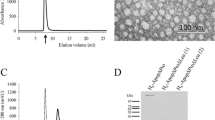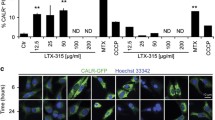Abstract
Apoptin, a protein of the chicken anemia virus (CAV), consists of 121 amino acids (aa) and represents a novel, potentially tumor-specific therapeutic and diagnostic agent. The C-terminal part of Apoptin (aa 81–121) is believed to contain a bipartite nuclear localization signal (NLS) (NLS1: aa 82–88 and NLS2: aa 111–121), which is only active in tumor cells after phosphorylation of threonine108 by tumor-specific cytoplasmic phosphokinases. Furthermore, a nuclear export signal (NES) (aa 97–105) seems to enable nuclear export of Apoptin only in healthy cells. The specificity for tumor cell nuclei also applies to the truncated C-terminal part of Apoptin (aa 81–121), which therefore represents a highly attractive peptide sequence for peptide synthesis. Here we describe for the first time the synthesis of fluorescein isothiocyanate (FITC)- and Dansyl-labelled conjugates containing this C-terminal part of Apoptin, with either phosphorylated or nonphosphorylated threonine108. The phosphorylated conjugates were synthesized in an attempt to achieve nuclear accumulation in healthy cells, which lack cytoplasmic tumor-specific phosphokinases. Surprisingly, all the conjugates accumulated rapidly within the cell nuclei of both tumor and non-tumor cells from the bladder, brain and prostate and led to cell death. By coupling Apoptin81–121 to FITC and DOTA (1,4,7,10-tetraazacyclododecane-1,4,7,10-tetraacetic acid) at either the C- or N-terminus we could exlude that the coupling site is decisive for tumor cell-specific nuclear localization. The labels FITC, DOTA and Dansyl were not responsible for cell death in healthy cells because cell death was not prevented by using an unlabelled Apoptin81–121 peptide. Cellular and nuclear uptake of the FITC-labelled Apoptin81–121 peptide was almost completely abolished after altering the NLS2 (replacement of five arginines with serines).









Similar content being viewed by others
References
Noteborn MH, de Boer GF, van Roozelaar DJ et al (1991) Characterization of cloned chicken anemia virus DNA that contains all elements for the infectious replication cycle. J Virol 65:3131–3139
Zhuang SM, Shvarts A, van Ormondt H, Jochemsen AG, van der Eb AJ, Noteborn MH (1995) Apoptin, a protein derived from chicken anemia virus, induces p53-independent apoptosis in human osteosarcoma cells. Cancer Res 55:486–489
Danen-Van Oorschot AA, Fischer DF, Grimbergen JM et al (1997) Apoptin induces apoptosis in human transformed and malignant cells but not in normal cells. Proc Natl Acad Sci USA 94:5843–5847
Rohn JL, Zhang YH, Aalbers RI et al (2002) A tumor-specific kinase activity regulates the viral death protein Apoptin. J Biol Chem 277:50820–50827
Rohn JL, Zhang YH, Leliveld SR et al (2005) Relevance of apoptin’s integrity for its functional behavior. J Virol 79:1337–1338
Danen-Van Oorschot AA, Zhang YH, Leliveld SR et al (2003) Importance of nuclear localization of apoptin for tumor-specific induction of apoptosis. J Biol Chem 278:27729–27736
Guelen L, Paterson H, Gaken J, Meyers M, Farzaneh F, Tavassoli M (2004) TAT-apoptin is efficiently delivered and induces apoptosis in cancer cells. Oncogene 23:1153–1165
Poon IK, Oro C, Dias MM, Zhang JP, Jans DA (2005) A tumor cell-specific nuclear targeting signal within chicken anemia virus VP3/apoptin. J Virol 79:1339–1341
Poon IK, Oro C, Dias MM, Zhang J, Jans DA (2005) Apoptin nuclear accumulation is modulated by a CRM1-recognized nuclear export signal that is active in normal but not in tumor cells. Cancer Res 65:7059–7064
Heilman DW, Teodoro JG, Green MR (2006) Apoptin nucleocytoplasmic shuttling is required for cell type-specific localization, apoptosis, and recruitment of the anaphase-promoting complex/cyclosome to PML bodies. J Virol 80:7535–7545
Lee YH, Cheng CM, Chang YF, Wang TY, Yuo CY (2007) Apoptin T108 phosphorylation is not required for its tumor-specific nuclear localization but partially affects its apoptotic activity. Biochem Biophys Res Commun 354:391–395
Wadia JS, Wagner MV, Ezhevsky SA, Dowdy SE (2004) Apoptin/VP3 contains a concentration-dependent nuclear localization signal (NLS), not a tumorigenic selective NLS. J Virol 78:6077–6078
Subbarayan V, Sabichi AL, Llansa N, Lippman SM, Menter DG (2001) Differential expression of cyclooxygenase-2 and its regulation by tumor necrosis factor-α in normal and malignant prostate cells. Cancer Res 61:2720–2726
Mahajan SD, Schwartz SA, Shanahan TC, Chawda RP, Nair MPN (2002) Morphine regulates gene expression of α- and ß-chemokines and their receptors on astroglial cells via the opioid μ receptor. J Immunol 169:3589–3599
Eder IE, Corvin S, Maneschg C et al (2000) Selective culture conditions for different types of primary human bladder cells. World J Urol 18:371–375
Richard JP, Melikov K, Vives E et al (2003) Cell-penetrating peptides. A reevaluation of the mechanism of cellular uptake. J Biol Chem 278:585–590
Gerace L, Burke B (1988) Functional organization of the nuclear envelope. Annu Rev Cell Biol 4:335–374
Noor F, Wüstholz A, Kinscherf R, Metzler-Nolte N (2005) A cobaltocenium-peptide bioconjugate shows enhanced cellular uptake and directed nuclear delivery. Angew Chem Int Ed 44:2429–2432
Leliveld SR, Zhang YH, Rohn JL, Noteborn MH, Abrahams JP (2003) Apoptin induces tumor-specific apoptosis as a globular multimer. J Biol Chem 278:9042–9051
Acknowledgement
This study was supported by the Hertie-Foundation for Brain Research.
Author information
Authors and Affiliations
Corresponding author
Rights and permissions
About this article
Cite this article
Heckl, S., Regenbogen, M., Sturzu, A. et al. Value of apoptin’s 40-amino-acid C-terminal fragment for the differentiation between human tumor and non-tumor cells. Apoptosis 13, 495–508 (2008). https://doi.org/10.1007/s10495-007-0174-5
Published:
Issue Date:
DOI: https://doi.org/10.1007/s10495-007-0174-5




